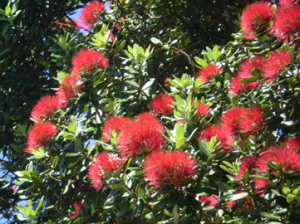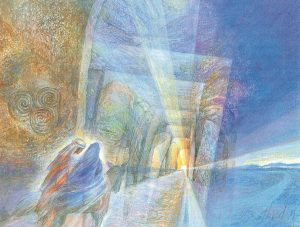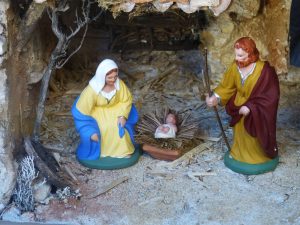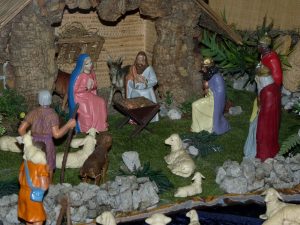Regional Leaders and Sisters representing their regions, have provided Christmas messages for you to reflect on and enjoy…
The Story of the Pohutukawa Tree

The pohutukawa tree (Metrosideros excelsa) with its crimson flower has become an established part of the New Zealand Christmas tradition. This iconic Kiwi Christmas tree, which often features on greeting cards and in poems and songs, has become an important symbol for New Zealanders at home and abroad.
In 1833 the missionary Henry Williams described holding service under a ‘wide spreading pohutukawa’. The first known published reference to the pohutukawa as a Christmas tree came in 1857 when ‘flowers of the scarlet Pohutukawa, or “Christmas tree”’ formed part of table decorations at a feast put on by Ngāpuhi leader Eruera Patuone. Several years later Austrian geologist Ferdinand von Hochstetter noted that settlers referred to it as such. The pohutukawa, he observed, ‘about Christmas … are full of charming … blossoms’; ‘the settler decorates his church and dwellings with its lovely branches’. Other 19th century references described the pohutukawa tree as the ‘Settlers Christmas tree’ and ‘Antipodean holly’…
Please continue reading below:
The Story of the Pohutukawa Tree (PDF)
Moya Campbell rsj
Regional Leader, Aotearoa New Zealand Region
[1] Image: ‘Pohutukawa tree’ obtained from https://nzhistory.govt.nz/media/photo/pohutukawa-flowers, (Ministry for Culture and Heritage), updated 14-Dec-2016.
The Meaning of Christmas
As we approach Advent and anticipate the feast of Christmas Day, many of us are concerned about how we will celebrate this special season with family and friends and with the wider community. Questions are being asked in all walks of life. How will midnight Mass be celebrated? How will the community experience Carol Singing? Will there be an extended family Christmas gathering? How will the Christmas Pageant be affected? How are relatives, friends and communities overseas coping with the Pandemic?
How will we celebrate Christmas this year while so many are grieving?
Father Richard Rolheier writes:
So, we rejoice this Christmas, aware of the ways we have been united by this pandemic and the strength of the sisters supporting and connecting each other wherever the need arose. There have been deaths, illnesses of loved relatives and friends, yet these were accompanied by an appreciation of each other, closeness and comfort in the knowledge that our love lives on and nothing can quell it. Let us continue to be flexible, to be open, to expect the unexpected, to look again into the horizon and to recall that joy is the meaning of Christmas.
This Christmas, may the blessings of the Christ Child bring us the strength he experienced when cradled in straw, the vulnerability and trust of a newborn and the resilience of his homeless parents.
Brigette Sipa rsj
Regional Leader, CentreWest Region
A Light in the Darkness
In our current global pandemic crisis, many people are riven with fear and anxiety. Suddenly life has become very fragile and we have come to realise that anything can happen to us from one minute to the next. Economics, policies, health care systems, religion, institutions of family and community life all have become abruptly insecure. In such circumstances, our normal certainties of life can quickly fade away leaving us doubting our ability to cope. Now, more than ever, we are being called to understand something of the true meaning of Christmas and the Incarnation story…
Please continue reading below:
A Light in the Darkness reflection (PDF)
Antoinette Dilworth rsj
Ireland Region
United in Spirit this Christmas
Three weeks before Christmas in 1899, taking advantage of a quiet day at Kincumber on the New South Wales Central Coast, Mary wrote her Christmas letter to the Sisters:

Mary greeted the Sisters, “Wherever this may find you, I with all my heart wish you a very happy Xmas and a bright happy New Year”.
On behalf of the Sisters and Affiliates of Queensland,
May this Christmas bring you joy, hope and new life, and may your coming year be bright, filled with blessings, grace and peace.
Lyn Stabler rsj
Regional Leader, Queensland Region
[1] Image: ‘Toward a New Dawn’ © M. Southard CSJ, www.marysouthardart.org. Used with permission.
Gifts and Presence
This is the time of the year when thinking about giving and receiving presents can loom large on our radar screens. Some search long and hard to find the most suitable gift for a friend or loved one. Others simply say “I have enough stuff. Don’t give me anything. I have all I need. Your presence is enough for me.” Some go to excess; others gift each other in simplicity, to show that their simple gift is a sincere gesture of love, of gratitude, of appreciation.
 Yes, Christmas is really the celebration of profound simplicity. It is Jesus in a manger. What we are really celebrating is the awesome, wonder-filled presence of a baby. We marvel at the thought that this tiny baby will grow into the voice of God. It seems incomprehensible that this vulnerable baby is our God, enfleshed as a human being. Just like us. This baby is God’s present, God’s gift to each of us, beautifully wrapped in human flesh. It is cause for great celebrations!
Yes, Christmas is really the celebration of profound simplicity. It is Jesus in a manger. What we are really celebrating is the awesome, wonder-filled presence of a baby. We marvel at the thought that this tiny baby will grow into the voice of God. It seems incomprehensible that this vulnerable baby is our God, enfleshed as a human being. Just like us. This baby is God’s present, God’s gift to each of us, beautifully wrapped in human flesh. It is cause for great celebrations!
At Christmas we rejoice that Jesus, Emmanuel is God with us, God within us. This Presence is alive in us and is the central focus of Christmas gift giving. Having received that Present, that precious gift, we are invited in turn to recognise that Presence in all those we encounter this Christmas and in all the experiences we have as we celebrate. Jesus-Emmanuel is there in all our encounters – in the tense times, in the sad or lonely times which may be ours this Christmas, as well as in the fun and joy-filled times. This year, more than ever, our experiences of the pandemic have reminded us that the simplicity of the gift of our compassionate presence is the most precious of all.
The mutual exchange of gifts is our way of celebrating the mind-blowing, the “shocking”, fact that God became one of us, in Jesus, the Prince of Peace. So, let’s be presence to others. Let the gift of our presence be our sign that this wondrous Presence is real in our world and it can make a difference.
Mary MacKillop invites us to reflect on the quality of our gift to others:
Where are the Shepherds?
Local councils and shopping centres have begun ‘dressing up’ their community spaces for Christmas. What a lovely surprise to find the nativity scene displayed amidst the lights and colour of the commercial world. Some nativity scenes are small and insignificant, perhaps found in one shop window but how wonderful to find larger, well-placed displays in shopping centres. Mary, Joseph and the baby Jesus are there and often the three well-dressed Kings with their gifts tastefully presented.
But where are the shepherds?
I went checking the Christmas cards available and found that Mary, Joseph, baby Jesus, the Kings and a star are there in varying combinations but no shepherds.
We sing about shepherds in traditional Christmas Carols. When we coordinate children’s pageants, we have plenty of shepherds. We knew the shepherds well once, but it seems they are disappearing from public display and possibly from our consciousness.

This year, the shepherds remind me of those many ordinary workers who have been working tirelessly day after day, caring and protecting those who come into their care. During COVID-19, we have been made aware of the many, many ordinary workers who are now heralded as the heroes:
The Aged care workers, the cleaners, the lowly paid hospital workers, the security people and nurses, have a new-found dignity in the public eye.
Those who have supported refugees, asylum seekers, prisoners, the homeless, those suffering domestic violence and those in quarantine.
Those seamen stranded on boats throughout the world keeping imports and exports flowing, not able to disembark anywhere.
Teachers, parents and grandparents who took on the task of education of children when schools were closed.
You know all these people and many more who are the ordinary, often low paid workers or volunteers who have been drawn to service and care as were the shepherds.
The Shepherds need to be in the nativity scene this Christmas, if not in our towns and cities, then in our minds and hearts. The good news of the Christmas story is that the Shepherds had the best view and ever since, have announced to the world that God loves the humble and lowly ordinary worker.
Anne Porter rsj
Regional Leader, New South Wales Region
[1] Photo: Religion-christmas-775015 obtained from PxHere. Used with permission.
